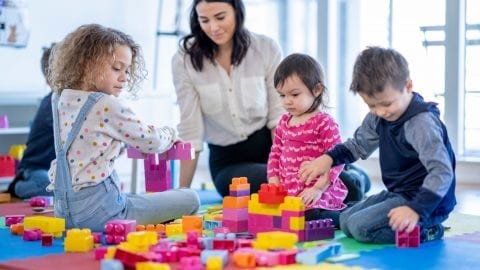Choosing the right early childhood education approach for your child can be daunting. With so many different options available, it’s tough to know which one is right for your family. In this blog post, we will explore the different approaches to early childhood education and help you decide which one is right for you and your child. We will discuss the Montessori method, the Reggio Emilia approach, Waldorf education, and more.
What is Early Childhood Education?
The play-based approach is the most common type of early childhood education. This approach emphasizes learning through play. Children learn best when they are allowed to explore and discover on their own. This type of education is often seen in preschool and kindergarten classrooms.
The Montessori method is another popular type of early childhood education. This approach was created by Dr. Maria Montessori. It emphasizes hands-on early learning where children can learn at their own pace. This type of education is often seen in private schools and Montessori schools.
The Reggio Emilia approach is a child-centred and project-based early childhood education. This approach was developed in the city of Reggio Emilia in Italy after World War II. It emphasizes learning through collaboration and exploration. This type of education is often seen in Early Childhood Education programs in Europe and North America.
The Waldorf-Steiner approach is a holistic type of early childhood education that emphasizes the development of the whole child – body, mind, and spirit. Rudolf Steiner developed this approach in the early 1900s. It stresses the importance of imagination, creativity, and nature in the learning process. This type of education is often seen in Waldorf schools.
SHEL in Australia, for example, focuses on providing high-quality early childhood education that is accessible to all families. Not only can you easily find a SHEL center near you, but you can also enroll your child in one of their many programs.
The Pros and Cons of Each Approach
Montessori schools focus on providing a child-centred environment where kids can explore and learn at their own pace. This hands-on approach to learning is designed to promote independence and self-motivation. Pros: The Montessori method fosters independent thinking and encourages children to learn at their own pace. It also promotes social skills as children learn to interact with others in a classroom setting. Cons: The Montessori method can be expensive, as it requires special equipment and trained teachers. Additionally, some parents feel that this method is too permissive, as it allows children to roam freely around the classroom and make noise while they work.
Reggio Emilia schools place an emphasis on project-based learning, where kids work together on long-term projects that require research and critical thinking skills. This approach also focuses on developing relationships between teachers and students, as well as between students and their families. Pros: The Reggio Emilia approach teaches teamwork and communication skills, both of which are essential in the modern workplace. Additionally, this approach is very flexible, allowing teachers to tailor their lessons to the needs of each individual child. Cons: The Reggio Emilia approach can be time-consuming and expensive, as it requires special materials and trained teachers. Additionally, some parents feel that this approach is too open-ended, as it does not provide a clear structure for learning.
The Waldorf Method
Waldorf schools focus on providing a well-rounded education that incorporates the arts, movement, and academics. This approach is designed to promote creativity, critical thinking, and social skills. Pros: The Waldorf method teaches kids to think creatively and to appreciate the arts. It also promotes social skills as children learn to interact with others in a supportive and nurturing environment. Cons: The Waldorf method can be expensive, as it requires special materials and trained teachers. Additionally, some parents feel that this approach is too restrictive, as it does not allow for much independent exploration.
SHEL centers on a play-based approach to learning, which incorporates both indoor and outdoor activities. This method is designed to promote social skills, physical development, and creativity. Pros: The SHEL approach is flexible and allows children to learn at their own pace. It also promotes social skills as children learn to interact with others in a playful environment. Cons: The SHEL approach can be expensive, as it requires special materials and trained teachers. Additionally, some parents feel that this approach is too permissive, as it does not provide a clear structure for learning.
How to Implement an Early Childhood Education Program
1. The Montessori Method: This method focuses on allowing children to learn through exploration and discovery. Children are given a lot of freedom to move around and explore their environment. In order to implement this method, you will need to create an environment that is safe and stimulating.
2. The Reggio Emilia Approach: This approach emphasizes the importance of the environment in supporting children’s learning. It also places a strong emphasis on collaboration and communication. In order to implement this approach, you will need to create a supportive and collaborative environment.
3. The Waldorf Approach: This approach focuses on providing a warm and nurturing environment for children. It also emphasizes the importance of nature and the outdoors. In order to implement this approach, you will need to create an environment that is safe and inviting.
4. The High Scope Approach: This approach emphasizes active learning and hands-on experiences. In order to implement this approach, you will need to provide a variety of materials and opportunities for children to explore. Not only that, but you will also need to create a safe and supportive environment.
5. The Creative Curriculum: This approach is based on the idea that children learn best through exploration and discovery. It also emphasizes the importance of the environment in supporting children’s learning. In order to implement this approach, you will need to provide a variety of materials and opportunities for children to explore. Not only that, but you will also need to create a safe and supportive environment.

There is no one right way to provide early childhood education. Every child is different and every family has different needs. The most important thing is to find an approach that works for you and your child. There are many different approaches to early childhood education, so do some research and find the one that feels right for you. You and your child will be glad you did.










